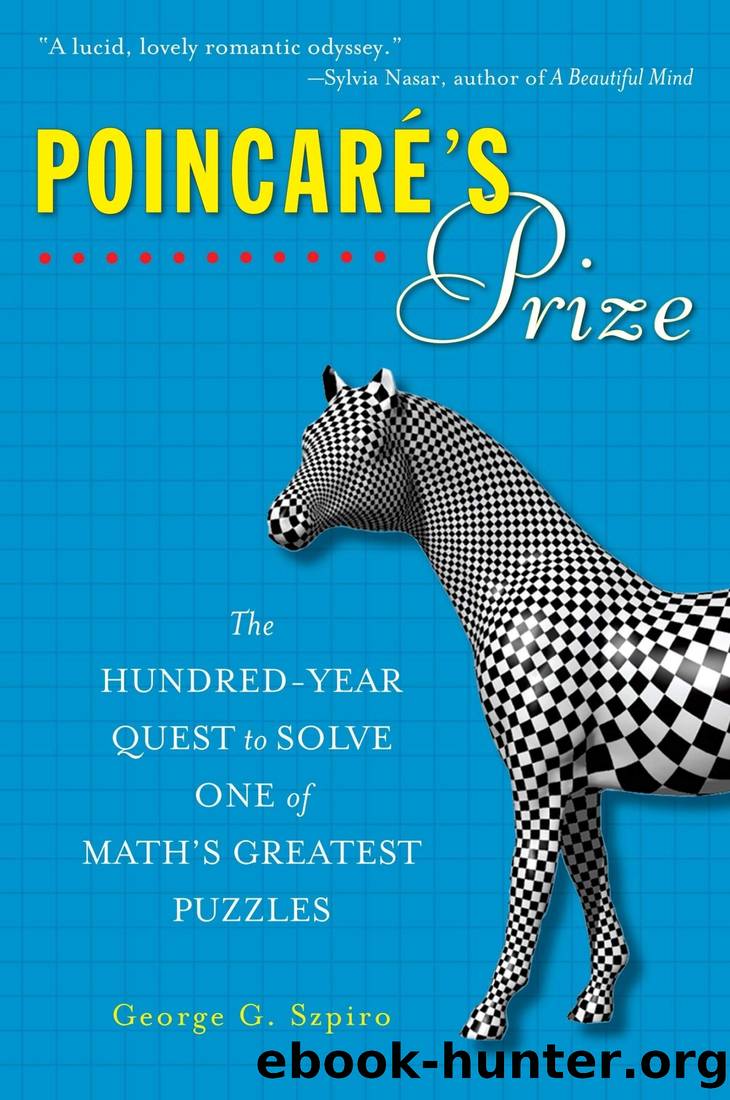Poincare's Prize: The Hundred-Year Quest to Solve One of Math's Greatest Puzzles by George G. Szpiro

Author:George G. Szpiro [Szpiro, George G.]
Language: eng
Format: epub
Tags: Autobiography, Biography, History & Philosophy, Mathematics, Science & Technology, Topology
ISBN: 9781440634284
Google: iEBOce-4S2EC
Amazon: 0452289645
Publisher: Plume
Published: 2008-07-28T23:00:00+00:00
One rather unexpected distinction was a multipage profile about him in—of all places—the Mineralogical Record, a journal devoted to the collection of minerals. The reason for this unlikely journalistic piece is that Smale and his wife are avid collectors of natural crystals. The assemblage they have gathered over the decades is considered one of the world’s finest private collections. A book with a hundred color plates of the couple’s minerals was recently published under the title The Smale Collection: Beauty in Natural Crystals.
Smale’s preoccupation with Poincaré’s Conjecture began when he was still a doctoral student at the University of Michigan. He thought he had found a proof and excitedly rushed into a professor’s office to tell him all about it. The professor did not say much while Smale outlined his proof. Only after leaving the office did he realize that he had not used any hypotheses on three-dimensional manifolds in his “proof.” A few years later, while he was tanning on the beaches of Rio, Smale believed he had found a counterexample to the three-dimensional case. He wrote down the details, but when he reviewed his work, he found a mistake. So Smale’s attack on Poincaré’s Conjecture had got off to two false starts.
But he was not to be put off. His interests at that time had just started to center on dynamical systems, a theory that describes how manifolds move and flow when forces act upon them. So, while investigating how these topological objects develop over time, Smale hit upon a new way of decomposing them into cells. That, and his intimate knowledge of dynamical systems, would come in handy for a proof of the higher-dimensional Poincaré’s Conjecture.
The crucial ingredient in Smale’s proof was a new concept that he later developed into the so-called h-cobordism theorem. The word cobordism derives from the word border or boundary and refers to the connection between two manifolds. For example, if one manifold is a circle and the other manifold is a pair of disjoint circles, the cobordism would be something resembling a pair of pants: The single circle would be the waist and the pair of circles would be the exits for the legs. The preconditions of the theorem are that the cobordism fulfill certain requirements and that the two manifolds be simply connected, i.e., they must not be pretzels or similarly shaped objects. Given these postulates, Smale proved that the two manifolds are in some sense equivalent to each other—as long as everything takes place in dimension five or higher. A different interpretation of Smale’s theorem is that the cobordism between the two manifolds is equivalent to an “open” cylinder—i.e., a pair of pants or an open-ended rubber pipe.
To prove Poincaré’s Conjecture in higher dimensions one must ascertain that all contractible, compact manifolds can be morphed into a sphere (the surface of a ball). Let us investigate such a manifold. First, remove two disks from it. With the help of the h-cobordism theorem it can be shown that what remains of the manifold is equivalent to an open cylinder.
Download
This site does not store any files on its server. We only index and link to content provided by other sites. Please contact the content providers to delete copyright contents if any and email us, we'll remove relevant links or contents immediately.
| Algebraic Geometry | Analytic Geometry |
| Differential Geometry | Non-Euclidean Geometries |
| Topology |
Weapons of Math Destruction by Cathy O'Neil(5070)
Factfulness: Ten Reasons We're Wrong About the World – and Why Things Are Better Than You Think by Hans Rosling(4041)
Factfulness_Ten Reasons We're Wrong About the World_and Why Things Are Better Than You Think by Hans Rosling(2764)
Descartes' Error by Antonio Damasio(2757)
A Mind For Numbers: How to Excel at Math and Science (Even If You Flunked Algebra) by Barbara Oakley(2700)
TCP IP by Todd Lammle(2657)
Applied Predictive Modeling by Max Kuhn & Kjell Johnson(2500)
Fooled by Randomness: The Hidden Role of Chance in Life and in the Markets by Nassim Nicholas Taleb(2435)
The Book of Numbers by Peter Bentley(2419)
The Tyranny of Metrics by Jerry Z. Muller(2417)
The Great Unknown by Marcus du Sautoy(2200)
Once Upon an Algorithm by Martin Erwig(2158)
Easy Algebra Step-by-Step by Sandra Luna McCune(2137)
Practical Guide To Principal Component Methods in R (Multivariate Analysis Book 2) by Alboukadel Kassambara(2104)
Lady Luck by Kristen Ashley(2087)
Police Exams Prep 2018-2019 by Kaplan Test Prep(2046)
Linear Time-Invariant Systems, Behaviors and Modules by Ulrich Oberst & Martin Scheicher & Ingrid Scheicher(1990)
All Things Reconsidered by Bill Thompson III(1968)
Secrets of Creation, Volume 1: The Mystery of the Prime Numbers by Watkins Matthew(1877)
